Origin PC EON17-SLX Gaming Laptop Review
Why you can trust Tom's Hardware
Gaming Benchmarks
Alien: Isolation
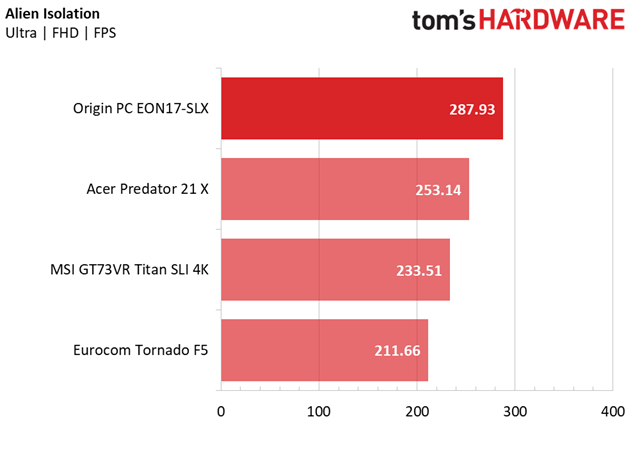
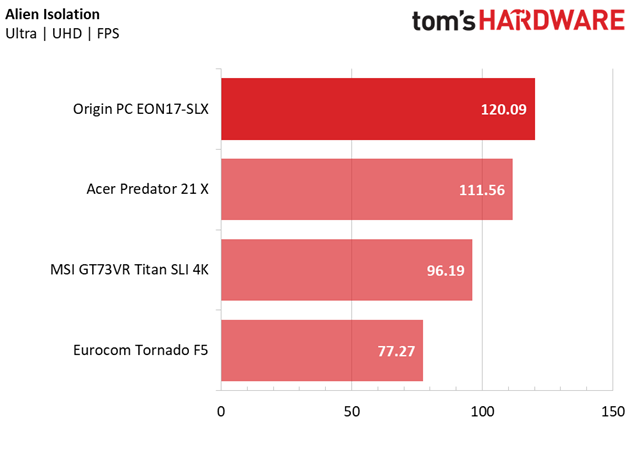
We're not surprised that the Origin PC EON17-SLX claims first place in Alien Isolation, even against the formidable Acer Predator 21 X. It gets a 13% boost.
That second GTX 1080 provides an additional 76 frames, or 26% more performance, compared with the single GPU on the Eurocom unit. The Origin's multi-GPU scaling is more impressive than that of the Acer, which only provides 16% more performance than the Tornado F5.
At UHD, the additional CPU power of the Origin laptop makes less of a difference as the emphasis shifts even more toward the GPU. The performance gap between the Origin and the Acer closes to 7%, or a mere 9 frames.
Ashes of the Singularity
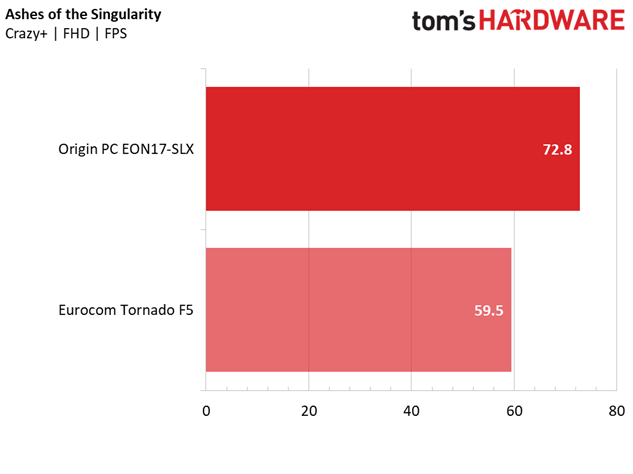

[NOTE: Previously, we didn't test the Acer Predator 21 X or MSI GT73VR Titan SLI with multi-GPU support in Ashes of the Singularity, so their scores are omitted from the results]
Ashes of the Singularity provides an excellent challenge with a hefty platform-based workload. The Origin pulls the frame rate well above the 60 FPS threshold at FHD, scoring 18% higher than the Eurocom unit, which falls just shy of the 60 FPS mark.
UHD punishes the frame rate, although not by much, surprisingly. The EON17-SLX delivers 54.3 FPS, or about a 25% performance degradation. This places it just close enough to reach 60 with minimal changes to the graphical settings.
Meanwhile, the Tornado F5 falls just above 40 FPS, or 31% lower than it performed at FHD. The gap is considerably wider.
Get Tom's Hardware's best news and in-depth reviews, straight to your inbox.
Bioshock Infinite

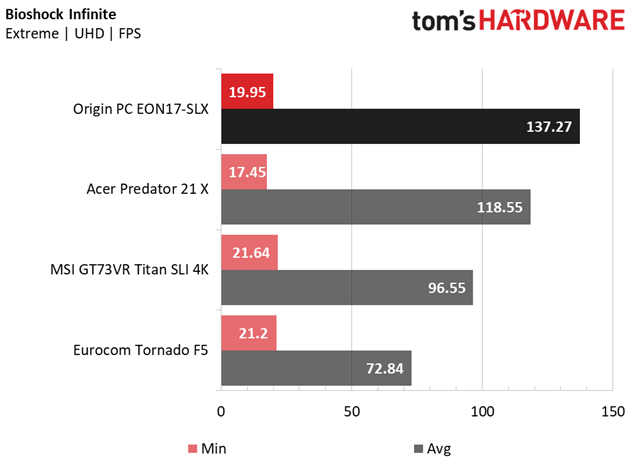
Bioshock Infinite presents another platform-taxing workload, and as such, the EON17-SLX punches far ahead of the competition thanks to its desktop-class processor and two GTX 1080s; the Acer laptop falls 20% below the Origin.
Comparing the Origin and the Eurocom laptops, we see that the second GPU gives a 37% performance edge at FHD.
The i7-7700K CPU becomes less relevant at UHD, although it still grants the EON17-SLX a 14% performance boost over the Predator 21 X. On the other hand, gap between the Eurocom and Origin laptops grows significantly to 47%.
DiRT Rally


Just like our last few titles, DiRT Rally rewards balanced platform strength, and the Origin and Eurocom perform well thanks to their powerful CPUs. The i7-7700K grants the EON17-SLX 13% more performance over the Acer, whereas the Acer’s second GTX 1080 only provides an additional 10% over the Eurocom. The performance gap between MSI's Titan SLI and Tornado F5 is even slimmer. Ultimately stronger graphics horsepower is the better performance indicator in this game.
For example, at UHD, the i7-7700K makes less of an impact. Even the Titan SLI earns a greater lead over the Eurocom.
Grand Theft Auto V
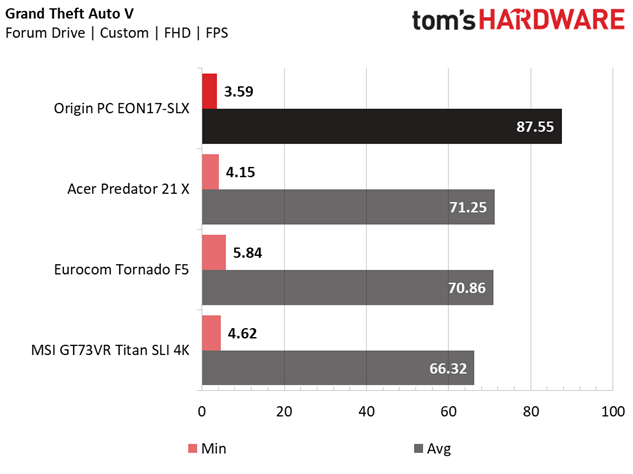

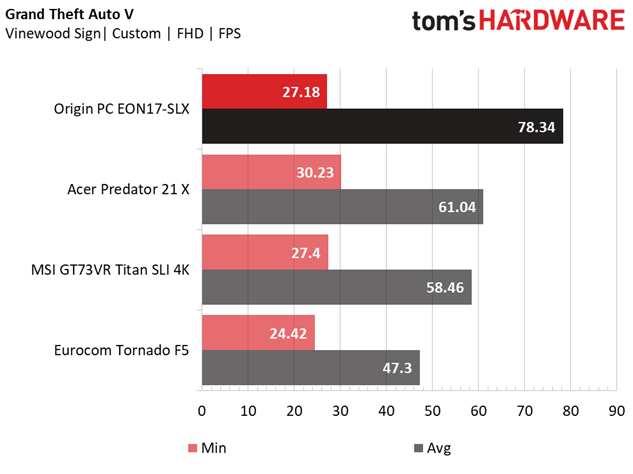
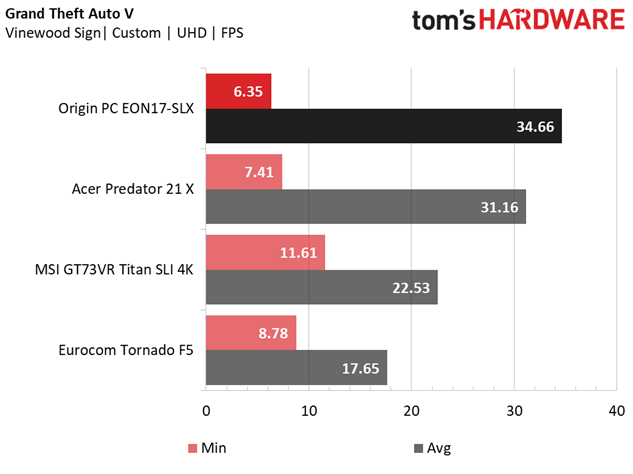
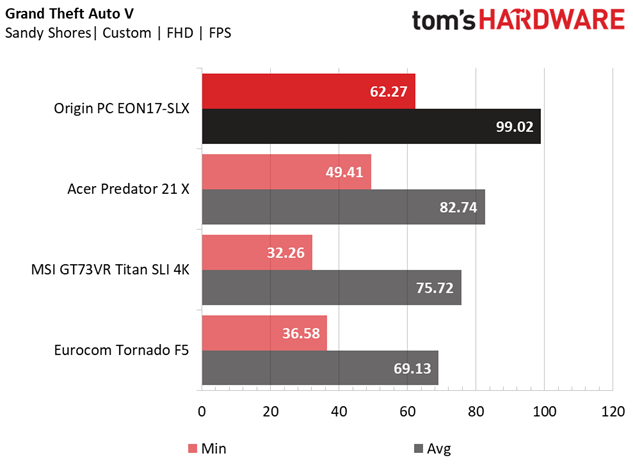

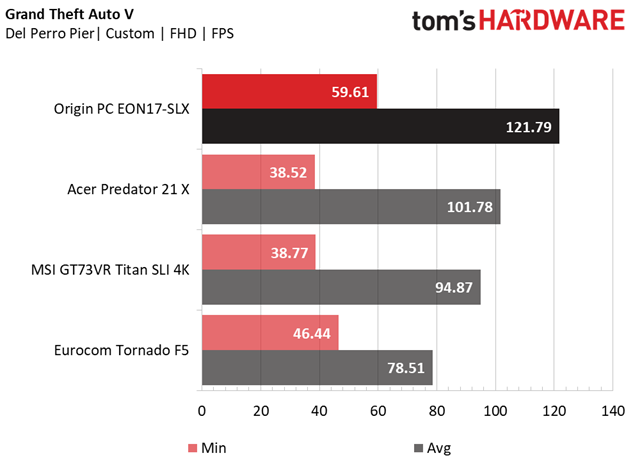

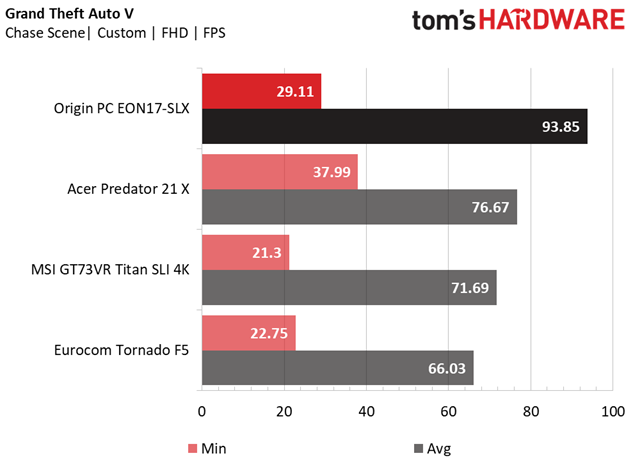
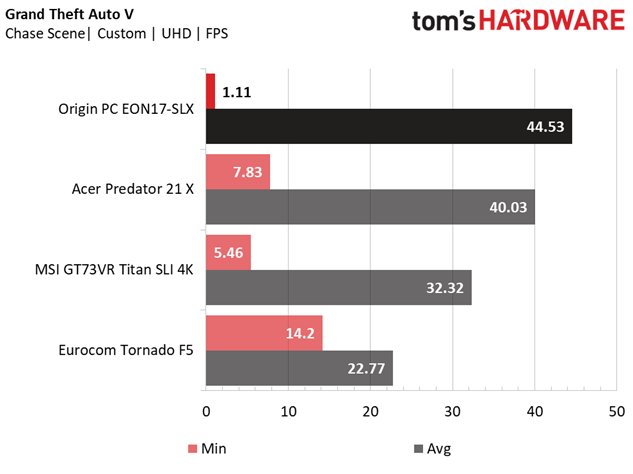
If Ashes couldn’t bring the EON17-SLX to its knees, then perhaps Grand Theft Auto V can, Not quite. GTA V hosts a handful of benchmarks with varying degrees of complexity, with the Vinewood Sign scene being the most strenuous because of how it renders distant objects. Even the Predator 21 X can barely maintain 60 FPS here, but the Origin laptop does fine at FHD.
Unfortunately, the Origin loses its massive lead when we ramp up the resolution. In most scenes, it maintains over 40 FPS, which is serviceable if you turn down anti-aliasing. However, the Vinewood Sign scene pulls the framerate down to 35 FPS, almost in line with the Predator 21 X. We won’t be seeing stellar performance on a maxed out GTA Vat UHD any time soon.
GRID Autosport
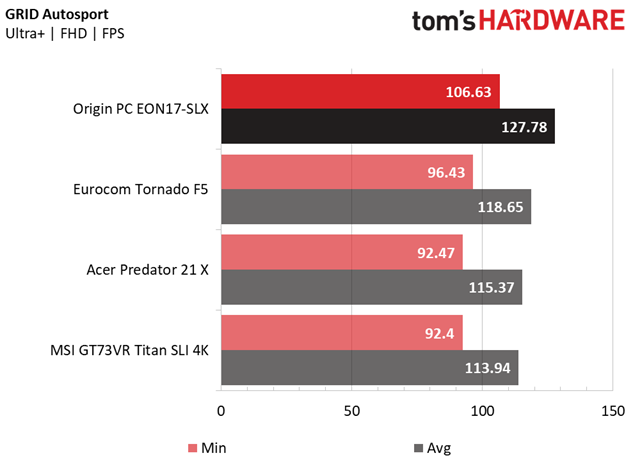

GRID Autosport demands adequate CPU performance, much like many of our previous titles. In fact, multi-GPU setups hardly provide a worthwhile improvement, at least at FHD. The EON17-SLX only outperforms the Tornado F5 by 11%, which is rather unimpressive.
Higher pixel density calls for more GPU resources; the performance gap nearly doubles at UHD. In the grand scheme of things, this 20% scaling (with multiple GPUs) is still unimpressive.
Hitman
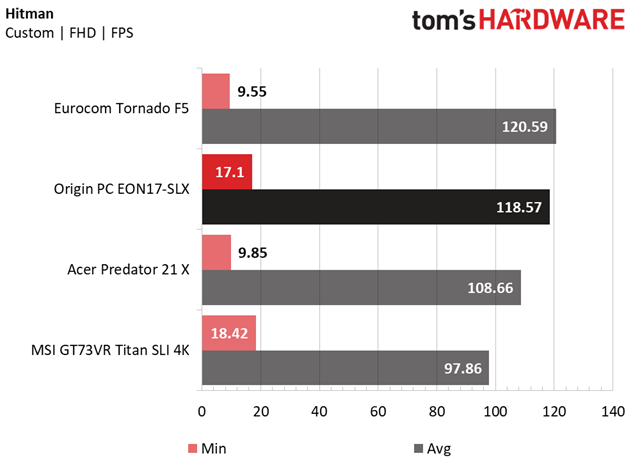
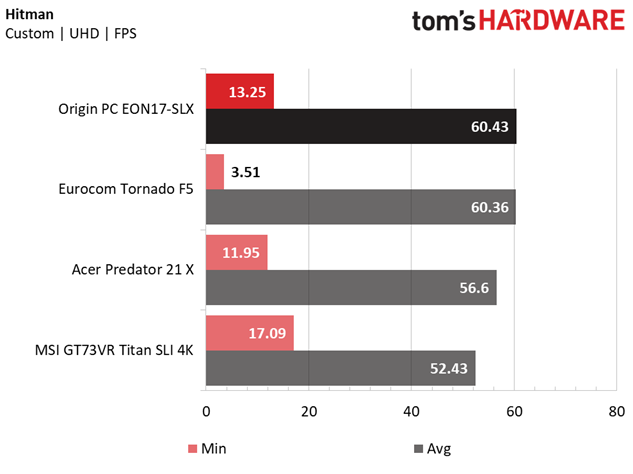
Hitman performance at DX11 doesn't seem to reward multiple GPUs, despite supporting them. The Titan SLI and Predator 21 X suffer the most and the EON17-SLX performs on par with the Tornado F5.
UHD illustrates a similar picture, with the mobile processor-based laptops playing second fiddle to Eurocom and Origin. A GTX 1080 with a desktop processor provides just enough performance to maintain 60 FPS, but a second GTX 1080 gives the Origin laptop on additional boost.
Metro: Last Light Redux
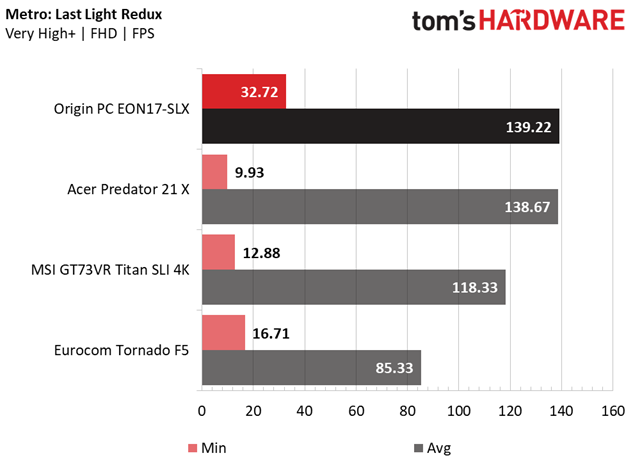
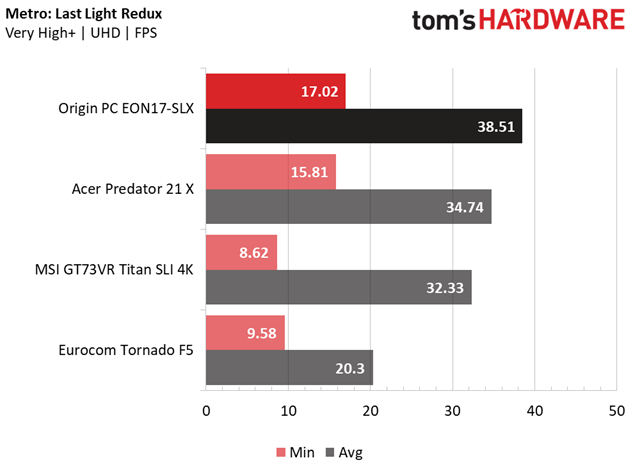
Metro: Last Light Redux provides a good change of pace because of its demands of the GPU. Both dual GTX 1080 configurations provide roughly 39% scaling over a single card.
Neither is capable of 60 FPS at UHD, however. The EON17-SLX’s performance falls by 72%, landing it below 60 FPS. The i7-7700K proves to be its saving grace, however, because the Predator 21 X experiences an even greater performance hit.
Rise of the Tomb Raider
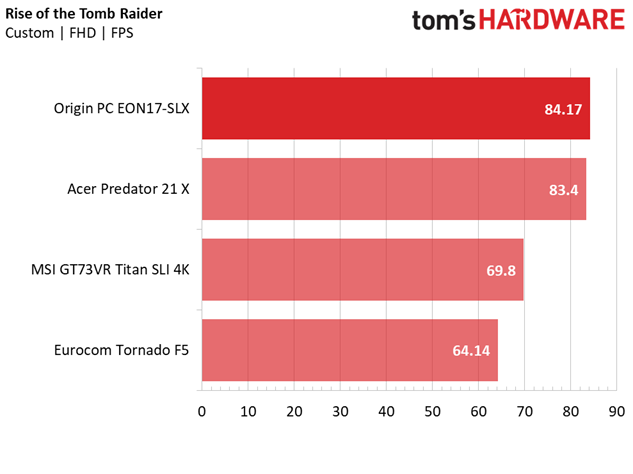

Rise of the Tomb Raidertells a similar story, but it has an even heavier workload than Metro. A single GTX 1080 provides enough horsepower to maintain 60 FPS, while the EON17-SLX and Predator 21 X breeze past easily. Scaling isn’t as great, with a second GTX 1080 adding only 24% more performance.
The UHD tax also punishing here. The Origin experiences a 59% frame rate loss. GPU scaling rises to 44%, as every ounce of GPU resource is needed to stay above water.
The Division
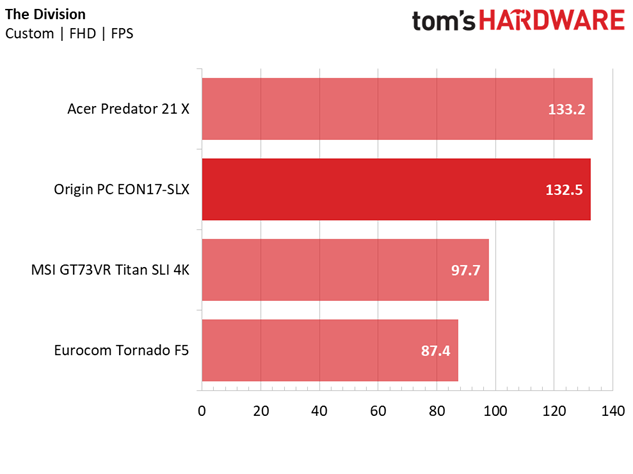

The Division’s benchmark workload is similar to Metro’s; it’s GPU-intensive, but not to the extent of RotTR’s benchmark. All of our systems deliver 60 FPS with ease. The EON17-SLX’s i7-7700K has a negligible impact on performance.
Quadrupling the resolution reduces the Origin’s frame rate by 55%, where it just clinches 60 FPS.
Thief
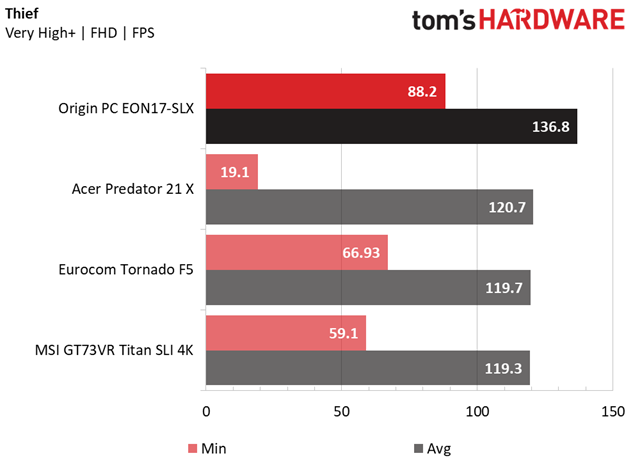

We return to a platform-based workload using Thief. Balance is the key here at FHD, where the Acer Predator, MSI Titan SL, and Eurocom Tornado all finish in a virtual tie, with the Origin EON17-SLX rising slightly above the crowd by about 12%.
Bumping up the resolution to UHD widens the gap between the Eurocom and the MSI laptop, and the Acer becomes a bit more competitive. Clearly GPU is playing a much stronger role here at 4K.
MORE: Best Gaming Laptops
MORE: Gaming Laptop Previews
MORE: All Laptop Content
Current page: Gaming Benchmarks
Prev Page Synthetic Benchmarks Next Page Battery, Thermal & Display Testing-
g-unit1111 What's up with laptop manufacturers including A/C adapters that are the size of a small textbook? Does it really take a huge A/C adapter to power laptops these days?Reply -
Rookie_MIB Heck, at $3600 for the MSI, you could take the difference and build a VERY good full blown desktop class gaming machine.Reply -
the nerd 389 Just curious:Reply
Have you guys ever considered testing using an external display so you can do a frame-time/F-CAT analysis?
I get the feeling that the cooling solution in this laptop is coming up short, and that would show up in your frame time variance tests. -
TMTOWTSAC To be fair, trying to effectively cool a pair of 1080's along with a 7700k plus a 4k screen all shoehorned into an 18 inch laptop would probably require the bottom of the laptop to consist entirely of fans at rpms so high the laptop hovers in midair.Reply
Actually...that would be a completely awesome no-lap-needed computer/drone. -
TJ Hooker Reply
Why "LOL"? If the cooling solution is insufficient, the components could throttle (intermittently), resulting in stuttering, which would show up in frame time measurements.19980951 said:"cooling solution"
"show up in your frame time variance tests."
LOL -
FritzEiv Reply19981179 said:
Why "LOL"? If the cooling solution is insufficient, the components could throttle (intermittently), resulting in stuttering, which would show up in frame time measurements.19980951 said:"cooling solution"
"show up in your frame time variance tests."
LOL
In many of our laptop reviews now, especially when we started seeing odd behavior with Max-Q laptops, we started looking at temperatures during gaming benchmark runs. When we see results that don't seem quite right (say two laptops share a configuration -- GPU, CPU, DRAM), we're going back and re-running the tests; and in fact, we're starting to collect more of this information just so that we have it, since we do have to send these samples back.
Further, we have discussed showing more frame time data, just like we do in our gaming tests on CPUs and Graphics Cards. We're in the middle of re-tooling some of our scripts, but once we have that pretty much automated, we may start doing that in our laptop reviews.
Finally, we're also trying to up our game, so to speak, in all areas here. We've done some display calibration, we've had Chris Ramseyer devise some better storage tests, and Igor has worked with us on dialing in the thermal imaging. We'll keep pushing all of it, so thanks for the suggestion(s). -
Kunra Zether I like the overall design it's nice and clean cut , I really love the led accents on the back of the screen. I feel like at this price point they should have a mechanical keyboard minus the number pad section. There should definitely be a better quality touch pad, and plastic really?? How about aluminum or even steel I mean at over $4K they give you plastic and on top of it I think you could design a better bezel around that screen too. Unfortunately aswell it sounds like that display is lacking aswell.Reply
Just build a nice home PC for about 2 to 3K and get a 1060 gaming laptop for on the go much better deal. -
lazymangaka I can't help but think if you need 2 AC adapters, you've gone too far in stuffing the laptop full of hardware.Reply
Also, why do you need 2 AC adapters, but they're still able to combine down to a single port? That seems like a lot of power to pack into one little port. -
ledhead11 My family asked and help pitch in years ago for an MSI GT80 TITAN 980M SLI rig for graduation. Mostly happy other than feeling burned when MSI abandoned various levels of support for it.Reply
That being said, it was one of the final of these types of SLI monsters to feature the single brick.
@Just curious:
"Have you guys ever considered testing using an external display so you can do a frame-time/F-CAT analysis?
I get the feeling that the cooling solution in this laptop is coming up short, and that would show up in your frame time variance tests."
For awhile I had it hooked up to a couple of different displays(a 1080p/120hz/3d and 1440p/144hz/3d). I can at least tell you that yes, if the external display offers greater potential the rig will do its best and eventually throttling happens. I never did f-cat with mine but did do plenty of gaming. Ultimately I just use it's built-in display now and as a portable high end desktop between work and home.
Now years later having built/upgraded my desktops to 1 1080TI and the other 1080 SLI I really feel they should just abandon any SLI and just stick with a 1080TI/1440p-144hz Gsync. I know they don't exist yet but honestly that would be the best path IMO. Less power, less heat, maybe back to single brick, smaller chasis/case(maybe) and a screen that would impress most hardcore gamers.